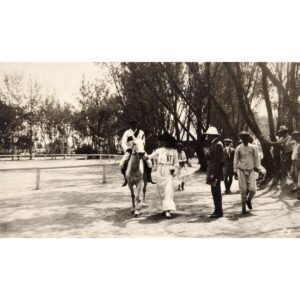Photography The Legation Quarter in Beijing from the Water Tower
A black-and-white photograph shows Beijing’s Legation Quarter (Dongjiaominxiang 東交民巷), situated between 1861 and 1959 in the Inner City (Neicheng 内城), east of present-day Tiananmen Square (Tiananmen Guangchang 天安門廣場), and south of the Forbidden City (Gugong 故宫 or Zijincheng 紫禁城). After the Second Opium War (1856–1860), several foreign delegations settled there and established embassies or legations of their countries. The city attracted many diplomats, soldiers, scholars, artists, tourists, and Sinophiles.
Although international agreements by which China granted extraterritorial rights to foreign powers over parts of its territory date back to the nineteenth century, jurisdiction over Beijing’s diplomatic quarter itself was not granted to foreign countries until 1901, after a 55-day siege of the quarter during the two-year Boxer Rebellion (Yuanyituan Yundong 義和團運動), which ended with the victory of the combined foreign forces. ... more
A black-and-white photograph shows Beijing’s Legation Quarter (Dongjiaominxiang 東交民巷), situated between 1861 and 1959 in the Inner City (Neicheng 内城), east of present-day Tiananmen Square (Tiananmen Guangchang 天安門廣場), and south of the Forbidden City (Gugong 故宫 or Zijincheng 紫禁城). After the Second Opium War (1856–1860), several foreign delegations settled there and established embassies or legations of their countries. The city attracted many diplomats, soldiers, scholars, artists, tourists, and Sinophiles.
Although international agreements by which China granted extraterritorial rights to foreign powers over parts of its territory date back to the nineteenth century, jurisdiction over Beijing’s diplomatic quarter itself was not granted to foreign countries until 1901, after a 55-day siege of the quarter during the two-year Boxer Rebellion (Yuanyituan Yundong 義和團運動), which ended with the victory of the combined foreign forces. Because of the cooperation of the Chinese court with the insurgents, China was forced to sign the Boxer Protocol (Xinchou Tiaoyue 辛丑條約), which also established the administration of the diplomatic quarter in Beijing.
By the beginning of the 20th century, all the major countries of the world were represented here, including the Netherlands, the United Kingdom, France, Germany, Japan, Russia, Italy, Spain, Belgium, and the United States. A smaller plot of land was also owned by the Austro-Hungarian Empire.
The special status of the diplomatic quarter was de facto ended by World War II, and in the course of subsequent political developments in the Chinese state, most of the buildings in the quarter were destroyed.
The photograph is the eighth of 449 photographs of Beijing and its surroundings in the album of Ivan Skušek Jr., purchased during his stay in Beijing (1914–1920). In the handwritten inventory of the album, the photograph is referred to as Legationviertel vom Wassertor. (DZ)





































Do you have a comment or additional information about the subject?